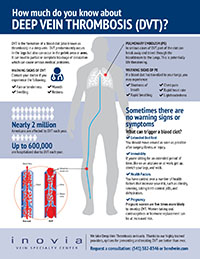A recent study published in the Journal American Medical Association (JAMA) found a significant association between varicose veins and deep vein thrombosis (DVT), and less clear potential associations with pulmonary embolism (PE) and peripheral artery disease (PAD).
The significance of this large, retrospective population study (over 400,000 people) is that varicose veins are a common condition but may be associated with increased health risks, especially for deep vein thrombosis (DVT). DVT, pulmonary embolism (PE), and peripheral artery disease (PAD) are all vascular diseases with severe systemic effects and may be life-threatening.
Do Varicose Veins Have a Direct Impact on DVT?
Researchers looked at the health records of more than 425,000 adults over a 12-year period. The study concluded that more work is needed to understand whether varicose veins directly cause blood clots or whether the two conditions have a similar origin due to a common set of risk factors.
About Deep Vein Thrombosis (DVT)
 Deep Vein Thrombosis, or DVT, is a condition most people associate with blood clots in the legs. DVT occurs when a blood clot (thrombus) forms in the deep veins, most commonly of the legs, pelvis, or arms.
Deep Vein Thrombosis, or DVT, is a condition most people associate with blood clots in the legs. DVT occurs when a blood clot (thrombus) forms in the deep veins, most commonly of the legs, pelvis, or arms.
Some DVTs may not have any symptoms but most cause dramatic pain, swelling, and warmth in the leg. If untreated, people with extensive DVTs are at risk of developing a pulmonary embolism, in which the blood clot breaks away and travels to the lung, which can be life-threatening.
According to Dr. Edward Boyle, Surgeon at INOVIA® Vein Specialty Center, “DVT is a common problem, especially after injury or trauma. We are committed to helping diagnose DVT in patients where this problem is suspected and help manage them through the process of recovery.”
DVT occurs in up to two million people each year in the United States alone. Pulmonary embolism — its potentially fatal complication — claims approximately 300,000 lives annually. This is more than breast cancer and AIDS combined.
About Varicose Veins
Varicose veins are swollen bulging veins under the surface of the skin that can be dark purple or blue in color. Although varicose veins can occur anywhere in the legs, they most often occur in the calves and behind the knees.
The function of veins is to bring blood back to the heart. Because the veins of the legs work against gravity, they contain one-way valves to prevent the blood from flowing backward as it travels back to the heart. If the one-way valve becomes weak, some of the blood can leak back down the vein, causing the veins to become congested. This causes what is known as vein reflux, or venous reflux.
In addition to causing veins to bulge and stretch, additional unpleasant side effects may include:
- Heavy and tired legs
- Aching and throbbing pain
- Swelling
- Itching
- Leg cramps
- Restless Leg Syndrome
Heredity is a primary factor in over 80% of varicose vein cases. Other contributing factors may include pregnancy, obesity, hormone therapy, standing or sitting for long periods of time and injury.
“We are committed to helping our patients understand their venous issues, and when indicated, treating them with the most up to date minimally therapies available to relieve their symptoms and reduce the potential for future problems” stated Dr. Edward Boyle.
Varicose Vein Treatment Can Help Reduce DVT Risk
The treatments to eliminate varicose veins and all vein abnormalities have improved dramatically in recent years. Radio Frequency Ablation (RFA) is the standard thermal treatments for large varicose veins.
In this technique, a very thin radiofrequency catheter is inserted into the damaged underlying vein. This technique works by heating the inside of the vein, which causes it to seal shut and disappear. To perform the procedure, the doctor uses an ultrasound machine to map the vein, and then inject the area with local anesthesia. The doctor places a needle into the lower end of the diseased vein, through which a small sheath is put into the vein. The radiofrequency catheter is then placed through the sheath and advanced to the upper end of the diseased vein. Local anesthesia is then delivered to the entire vein. The radiofrequency catheter heats the inside of the vein as it is slowly withdrawn back down the vein.
Performing an endovenous ablation eliminates the abnormal saphenous vein, which is often the source of most varicose vein issues.
Advances in non-thermal venous ablation treatments have resulted in additional treatment options.
- Varithena treatment involves the injection of medicine into the vein with ultrasound guidance to direct the medication into the abnormal vein, which causes the veins to close.
- VenaSeal Closure System is an innovative treatment that is the only procedure to use a medical-grade adhesive to close abnormal saphenous veins. The adhesive is inserted into the vein under ultrasound guidance via a small catheter and seals the vein shut.
Schedule a DVT Vein Consultation
Deep Vein Thrombosis (DVT) is taken very seriously at INOVIA® Vein Specialty Center. Thanks to our state-of-the-art vascular lab and our highly trained surgeons, options for preventing and treating DVT in our Oregon centers are better than ever.
If you are interested in learning more about varicose veins treatment options, simply fill out our Online Appointment Request Form or call any of our clinics in Northwest Portland , Tigard, Happy Valley, Hillsboro or Bend, Oregon.
